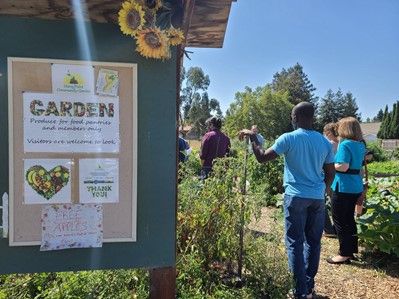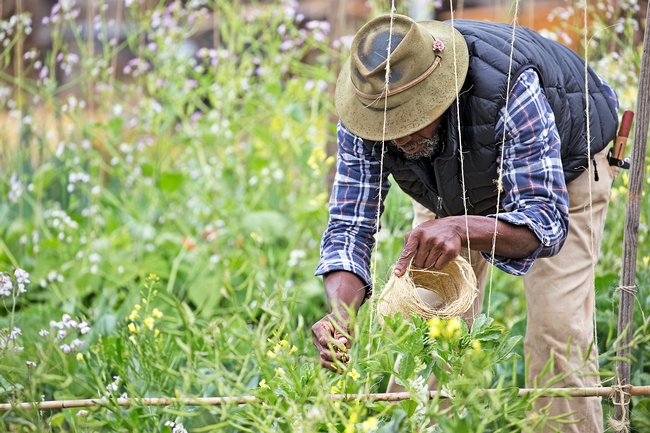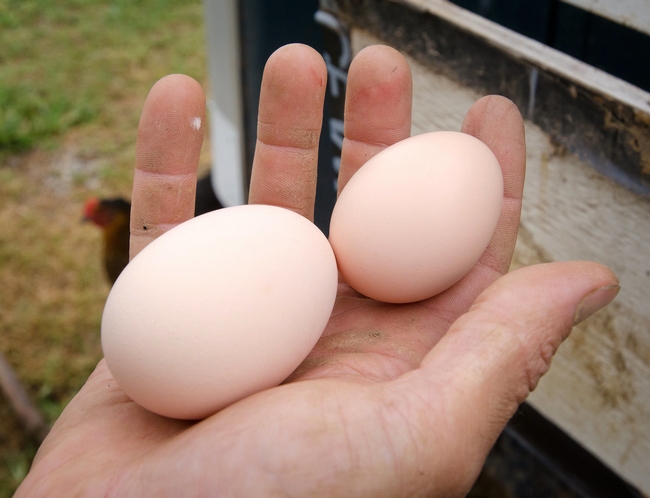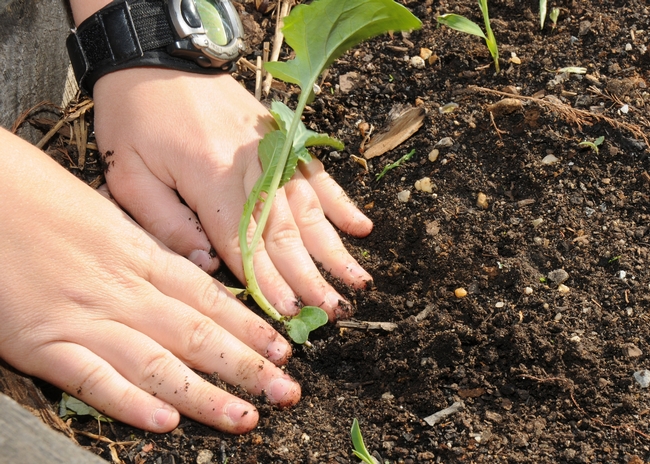- Author: Rob Bennaton, UCCE Bay Area Urban Agriculture Advisor
- Author: Julio Contreras, UCCE Urban Ag & Food Systems Program Community Education Specialist III
On August 25th, UCCE's Urban Ag & Food Systems Program tabled, paneled and supported the 8th Annual Food, Faith and Farms Conference in San Rafael, CA, hosted by Interfaith Sustainable Food Collaborative. The national Faithlands Conference, coordinated between Interfaith and the Agrarian Trust, which hosts the national Faithlands web page as a hub for sharing resources, followed on August 26-27. Rob Bennaton, Urban Ag and Food Systems Advisor, was panel moderator for the Successful Farms and Gardens on Faith Community Owned Lands panel. Julia Van Soelen Kim, North Bay Food Systems Advisor led a workshop focused on Making the Most of Commercial Kitchens, and Vince Trotter, Sustainable Ag Coordinator & Agricultural Ombudsman with UCCE Marin County, led a different workshop on Halal and Kosher: Exploring Relationships with Local Small Livestock Producers. Julio Contreras, UCCE Community Education Specialist III with the UCCE Urban Ag & Food Systems Program, shared urban farming information, supported and facilitated throughout the conference.
The discussion was on one of the most challenging hurdles for beginning and immigrant farmers: securing land to grow food. Meanwhile, religious institutions own lands throughout the United States that are often suitable for agriculture. These plots of land may vary in size from a 1,000 square foot community garden to over 100 acres. Partnerships can allow faith groups to simultaneously save resources, advance food security, connect traditional faith-based stories to land and agriculture, and help small farmers overcome economic and structural barriers. The presenters described innovative projects, including a farmer leasing from a Seventh Day Adventist middle school that successfully transferred ownership 3 times in Sonoma County, CA. There was also a farmer who leased land from her church while developing a farm project, allowing for her to scale to the point she qualified for a USDA loan for a piece of land that has a home and infrastructure. Finally, partnerships were highlighted in which a perennial food forest and seed bank on the grounds of a 4-acre Episcopal Church site were established.
The Faithlands movement is growing nationally to connect and inspire faith communities to use their land in new ways that promote ecological and human health, support local food and farming, enact reparative justice, and strengthen communities. On the Agrarian Trust's Faithlands web page, download the free FAITHLANDS TOOLKIT A Guide to Transformative Land Use. Interfaith is a regional and national organization which supports congregations of all faiths, denominations and backgrounds by connecting them with farmers and supporting farm stand initiation, farmers markets, and CSAs.
The idea is innovative and yet traditional, since so many faith-based groups are doing community-based food systems work, such as emergency food distribution, operating commercial-scale kitchens, or stewarding lands that could be cultivated by local farmers.
In particular, lands stewarded by faith-based groups in urban areas present a huge opportunity for cultivation by urban farmers, given high costs of land values in cities. Land for Good is another great organization that supports land transfers for farming and the development of land use agreements. Their amazing ToolBox web page has significant resources for building and negotiating leases for- and with- farmers and landowners.
The conference had a great turnout with powerful speakers and groups doing inspiring work around the nation. Speaker Rabbi Justin Goldstein from Yesod Farm+Kitchen in Fairview, North Carolina, opened the conference, sharing key points on building relationships for indigenous lands stewardship, and the process of returning this unceded land. Food justice and sustainability leaders representing 47 different religious communities were in attendance. While most came from the North Bay and East Bay, there were also participants from elsewhere in California and eight other states.
As described on the Interfaith Sustainable Food Collaborative website, “For the first time the conference included tours of farms and gardens at 7 different faith-community sites. Diverse speakers included 8 farmers growing food on lands owned by religious institutions. Ammar Ahmed of Islamic Circle of North America in Washington, D.C. spoke about the response of Muslim communities in the U.S. to hunger during theCOVID Pandemic. He called on attendees to help with the national effort by Muslim and Jewish groups to urge USDA to make kosher and halal meat available to observant Jews and Muslims through an emergency food program. Advocates are concerned about protein options available to observant individuals who utilize TEFAP, The Emergency Food Assistance Program (A letter signed by some 47 members of Congress went toUSDA last week; we will keep the Interfaith Food network apprised of how to help with this work.)” - Steve Schwartz, Executive Director, Interfaith Sustainable Food Collaborative.
In the Bay Area, South Berkeley, East and West Oakland, and South Hayward congregations have established small farms and gardens with their congregations. UCCE's Urban Ag & Food Systems Program with Alameda County RCD and Interfaith is providing technical support to a new East Alameda Gurdwara farming initiative managed by the Sikh community there. If you know of a faith-based group interested in this work, please reach out to Interfaith Sustainable Food Collaborative. Our Urban Ag collaborative team is also ready to work with you.
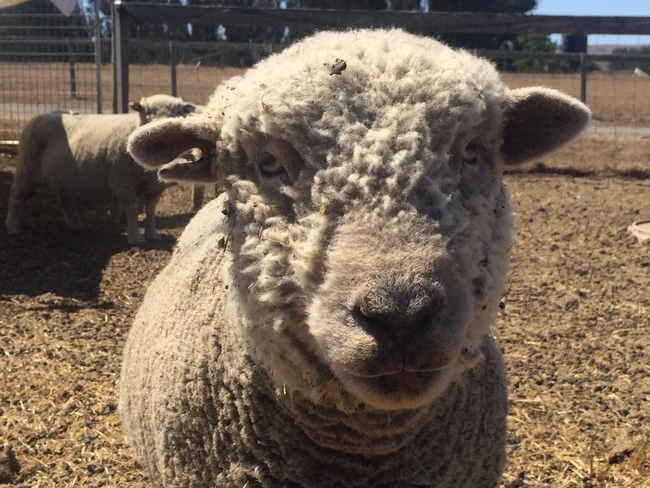
How I can keep my animals healthy? The first step to maintaining healthy animals is to practice good biosecurity and hygiene practices. This includes purchasing new animals from certified sources and knowing the herd/ flock status of the sources and health status. Another important practice the separation of the new animals and your current ones, there would ideally be a 14-30 day isolation period to prevent the transmission of diseases between resident animals and new animals. It is recommended to make sure livestock have regular vaccinations, routine veterinary care, and are closely monitored by owners for signs of illness. If signs of illness are detected, the separation of healthy animals from sick animals is crucial in stopping the further spread of diseases.
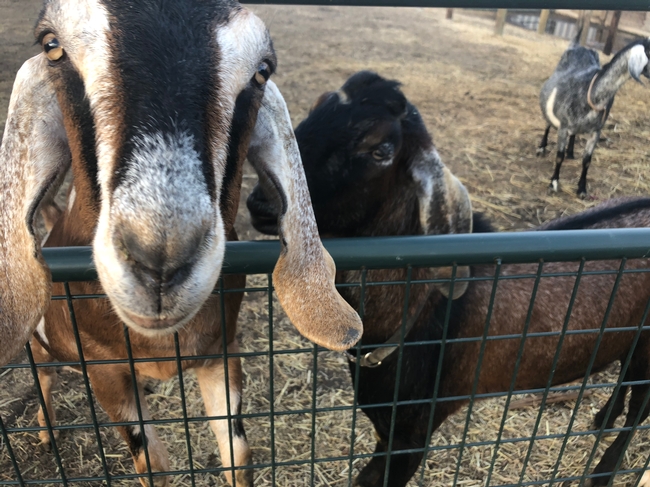
What practices can improve on small-scale and backyard livestock and poultry? In a recent study (Pires et al, 2019) in four western states in the US, 83.8% of small-scale and backyard livestock and poultry owners reported that they isolated sick animals from healthy ones and 76.6% kept newly purchased animals in quarantine. Other biosecurity practices were reported at a lower rate, such as the quarantine of returning (e.g., from fairs, shows) animals (49%), rodent/pest control (57.3%), wearing dedicated clothes when handling sick animals (49.5%), avoiding livestock contact with wildlife (50.7%) or limiting visitors (22.5%) (Pires et al, 2018).
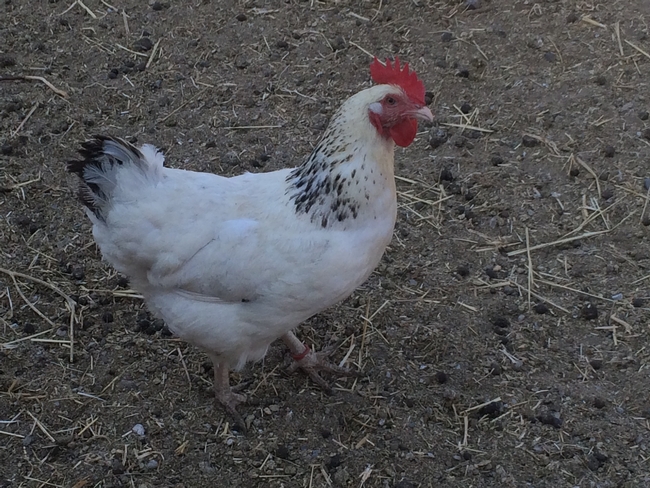
Summary. Backyard livestock and poultry owners should do their best to prevent contamination and disease spread. Purchasing the animals from reputable sources, maintaining a clean space for the animals, separating sick from health animals and proper sanitation efforts all play a collaborative part in the prevention of diseases and promotion of animal health and public health. Many sources such as published through different outreach outlets and are available online as well as veterinarians exist for how to properly maintain a backyard farm. It is important that backyard owners be aware and utilize the information out there and do what is best for themselves as well as the population. For more information, come back for more as this is the first of a series of articles that will cover backyard livestock and poultry.
- Pires, Alda F. A., et al. “Assessment of Veterinarians' Engagement with Backyard Poultry and Small-Scale Livestock Operations in Four Western States.” Journal of the American Veterinary Medical Association, vol. 257, no. 2, 2020, pp. 196–209., doi:10.2460/javma.257.2.196.
- Pires, Alda F. A., et al. “Small-Scale and Backyard Livestock Owners Needs Assessment in the Western United States.” Plos One, vol. 14, no. 2, 2019, doi:10.1371/journal.pone.0212372.
- Author: Jeannette E. Warnert
A summer of smoke and ash in many parts of California has raised questions about the safety of produce growing on farms and in the garden, eggs laid by chickens who peck around in ash-laden areas, and remediation needed to safely and effectively grow food in the future.
UC Agriculture and Natural Resources brought together experts who have researched the effects of previous fires' fallout and studied soil contaminants to share their insight in a two-hour webinar now available on YouTube.
“The No. 1 health concern during a fire is smoke inhalation, and it's been well documented that wildfire smoke can negatively impact both the heart and the lungs,” said Claire O'Brien, a pharmacology and toxicology doctoral student at UC Davis. “However, the chemicals found in the smoke don't just stay in the air. They can deposit onto plants and into soil and water.”
Although every fire is unique, some generalizations can be drawn from research conducted following previous fires. UC Cooperative Extension food systems advisor Julia Van Soelen Kim detailed a study conducted following the October 2017 wildfires in Sonoma County and across the North Bay.
With the help of UC Master Gardener and community volunteers, the researchers collected over 200 samples of homegrown collard greens, lettuces, kale and chard that were exposed to wildfire smoke and ash. A subset of the samples were analyzed by a private laboratory.
“There was very low concern about chemicals on produce,” Van Soelen Kim said. “No samples had detectable levels of lead, arsenic, mercury or chromium. And that's a huge sigh of relief.” However, analytical results vary by site, site history and by fire event, and few have pre-fire baseline data to compare with.
Van Soelen Kim said basic food-safety practices should be followed when preparing to eat food grown in a home garden, regardless of ash or smoke contamination.
“You should always wash your hands before and after harvesting, and wash your produce in running water to mitigate any kind of potential risk,” she said.
Are backyard chicken eggs safe to eat?
Another study outlined at the webinar used a similar process to determine whether there might be contaminants in the eggs laid by backyard poultry that live and feed in areas exposed to wildfire ash and smoke.
Scientists know from previous research that chickens exposed to lead in their environment can produce eggs with high lead content and that heavy metal content of ash from urban wildfires is higher than from rural wildfire.
“We combined those two pieces of research with what we know that chickens do all day: they peck at the ground for hours on end,” said Todd Kelman, a veterinarian in the School of Veterinary Medicine at UC Davis. “That makes for a pretty good hypothesis that urban wildfire could pose a risk for the production of eggs and poultry that contain heavy metals.”
Kelman and his team put out a call for eggs from backyard poultry and received samples from 344 premises in fire-affected and non-fire-affected areas of California.
Surprisingly, egg samples that contained higher lead levels came from parts of the state that were not directly impacted by ash and smoke.
“Did our data support our hypothesis that proximity to urban wildfire is a driving source for lead in eggs of backyard poultry? The answer is not so much,” Kelman said. “So, is it safe to eat eggs from your backyard poultry? We can't give you a definitive answer to that question. But we do suggest you assess your risk and reduce the risk of contamination.”
Practices that reduce the risk include keeping chickens off the ground, using a chicken feeder that prevents spillage onto the ground and making calcium readily available, for example in the form of oyster shells, because calcium can prevent the absorption of lead. Making sure that chickens are provided uncontaminated water is also an important part of risk reduction.
For confirmation on the safety backyard chickens and their eggs, lab tests for eggs are available for $60 from the California Animal Health and Food Safety Laboratory at UC Davis, or chickens may be submitted to CAHFS for necropsy.
Are soils safe for growing food after a fire?
Fire effects on soil is another consideration in burned areas, said UC Cooperative Extension urban agriculture advisor Rob Bennaton.
“Fires heat topsoil layers. They reduce the amount of living micro-organisms at the site of the burn, and also affect organic matter and nutrients. Ash deposits over time may make soils more alkaline,” he said. “As a result of these combined factors, there are temporary changes in nutrient levels and the capacity for soils to exchange nutrients for optimal plant growth and nutrition.”
With proper land care and management, soils can be remediated over time.
“It won't happen overnight. Soils were developed over millions of years,” he said.
Some ways to improve safety when gardening in fire-affected areas including keeping the soil covered with wood chips or other landscape mulch to reduce airborne soil dust. Use drip irrigation to prevent up splash onto the undersides of growing vegetables. Promote good drainage, especially at the bottom of slopes to prevent the concentration of contaminants.
Lab tests are often needed to determine the soils' post-fire characteristics. “Don't guess, but test,” Bennaton said.
The UC Master Gardener Program can provide technical assistance to help home gardeners find resources for home soil testing, he said.
Additional resources and information shared during the webinar include:
Post-fire soil resources and soil testing information
- UCCE publication on Soils in Urban Agriculture with soil testing & sampling information
- The UC ANR Healthy Soils Website, which has many resources worth reviewing.
- Tips for Interpreting Soil Analysis
- UC Master Gardener of Sonoma County 2018 workshop video “Effects of fire on soil”
Post-fire food safety
- Research on produce safety and backyard chicken egg safety after the 2017 wildfires in California is available on this web page. To view a past webinar recording with these research findings, click this link.
- Poultry wildfire resources from the UC Davis School of Veterinary Medicine:
- Best Practices for Produce Safety After Fire
- Understanding Risk: A community guide for assessing the potential health impacts of locally grown produce exposed to urban wildfire smoke
Firewise and sustainable home landscaping design in the defensible space zone
- Visit the UC Master Gardener Program of Sonoma County firewise landscaping web page.
- For a recent firewise & sustainable design and maintenance video by the Resilient Landscapes Coalition.
Impact of smoke & ash on plants
Urban Agriculture Soil Information
- Author: Jennifer Sowerwine
As our world grapples with the containment of the novel Coronavirus (COVID-19), essential services including food provisioning remain vital to the health and well-being of our communities. Yet, many small farms are struggling as they face rapid decline in sales as restaurants, schools and other farm-to-institutions programs close. Many urban farms and community gardens who share the mission of providing fresh, health and affordable food to some of our most vulnerable community members are trying to decide whether and how their operations can stay open, as Shelter-in-Place orders mandate social distancing in many of our counties.
The good news is that many Shelter-in-Place Orders list farms, farm stands and farmers' markets as “essential businesses” and are therefore exempt from the Shelter-in-Place orders. However, there are some key guidelines from the CDC regarding social distancing, heightened health and hygiene practices and cleaning and disinfecting procedures that can help minimize exposure and risk of spreading of the virus. The other good news is that there is no evidence to date of Coronavirus spreading through food and food packaging. The virus is thought to be spread mainly from person to person, however there is evidence that it can last for days on surfaces, thus the need to ramp up good health and hygiene practices, social distancing and cleaning & sanitizing of surfaces.
University of California research and extension faculty have compiled a list of valuable fact sheets and resources for farmers, community gardeners and other food system actors on the UC Davis Food Safety website to ensure that we can continue supplying fresh, healthy and affordable food to communities across our state. The following PowerPoint presentation, created for urban farmers in the San Francisco East Bay area, on Safe Handling Practices for Fresh Produce in a Time of Coronavirus Disease 2019 (COVID-19) provides what is known about COVID-19 and outlines best practices for safe food handling at the farm as well as links to a number of useful resources from the CDC, CDFA and others. A set of policies and procedures for safe food handling at the farm during COVID-19 provides step by step instructions for how to implement new food and health precautions on the farm including checklists, standard operating procedures and signage posting guidelines for preventing the spread of infection. Handouts for safe food handling at home can be distributed to customers receiving food from the farm.
During this challenging time, I am heartened by the quick and thoughtful responses by many extension, grassroots and institutional efforts, including Community Alliance with Family Farm's COVID-19 Responses and Resources for California Family Farms, Mutual Aid organizations where groups of young, healthy, and lower-risk people are bringing food and services to those who shouldn't be in public at all, and Rooting in Resilience that seeks to support local restaurants, farmers, and food systems workers as they weather this latest storm. Crisis can spawn innovation, and I am hopeful that through this, we will come out the other end with a more compassionate and resilient food system.
Jennifer Sowerwine is the UCANR/UCB Extension Specialist in Metropolitan Agriculture and Food Systems.
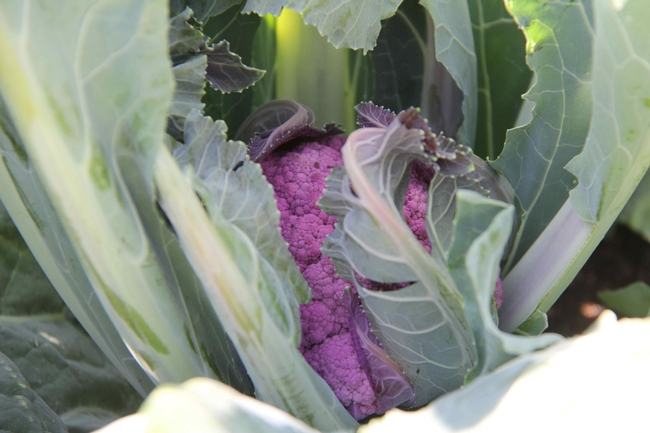
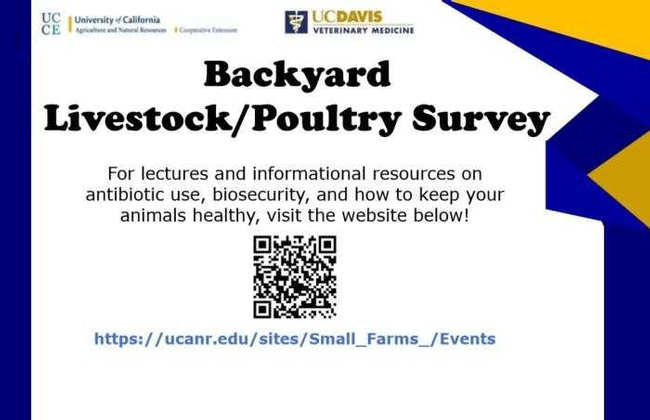
Conducted by the University of California Cooperative Extension and the School of Veterinary Medicine and funded by the California Department of Food and Agriculture, this survey will take about 20 minutes to complete. Provided information will be kept strictly confidential. We will not connect your name with your responses.
Originally created as part of the Healthy Animals, Healthy People workshop series in California, the survey is now open to all owners and small-scale producers of livestock and poultry in California regardless of workshop attendance. We would appreciate your time and participation in this survey, accessible here.


